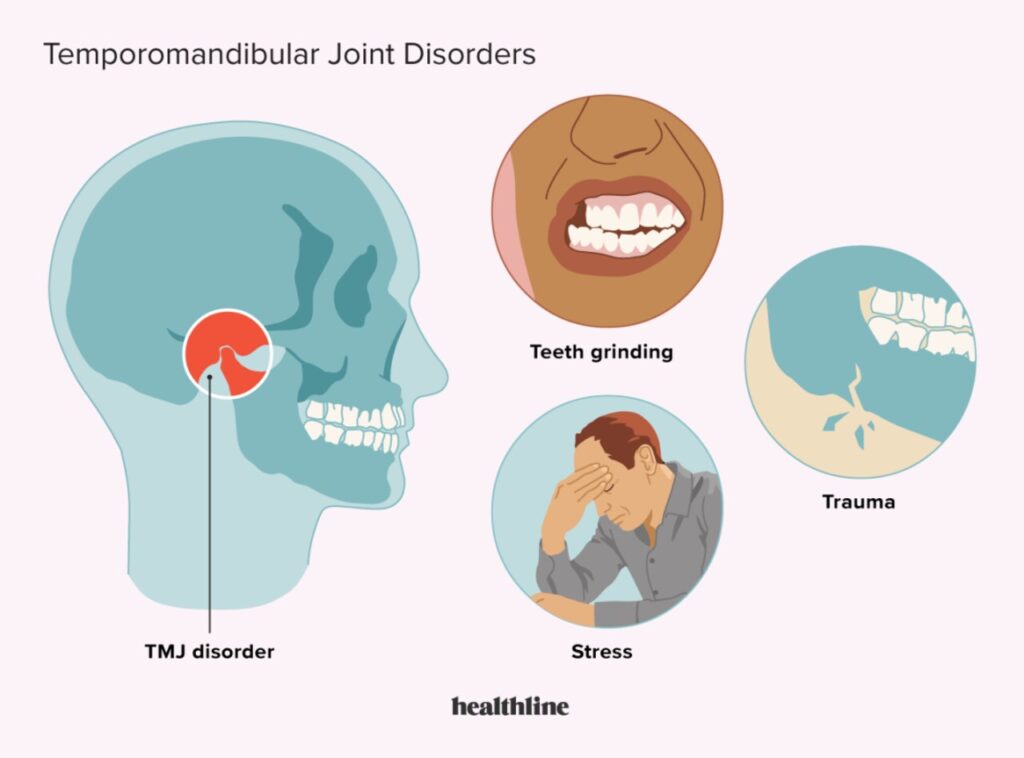


Dealing with jaw pain can significantly impact your quality of life, especially if it stems from temporomandibular joint dysfunction (TMD). In this detailed guide, we explore the causes and available treatments for TMD, focusing on effective physiotherapy approaches. Whether you’re experiencing acute pain or have been managing chronic symptoms, understanding the role of physiotherapy in TMJ treatment can be a game-changer in your journey toward recovery.
Temporomandibular joint disorders (or TMD), can be caused by a variety of different systems. Muscle and myofascial pain make up a large percentage of TMD diagnoses, as clenching and teeth grinding at night are common results of the closing muscles being tight and not relaxing. This in turn causes pain around the jaw area.
The joint itself can also cause pain, whether due to acute trauma, an issue with the connective tissue surrounding the joint, or arthritis. Neck pain can also affect the jaw joint, causing dysfunction. This is usually associated with headaches that seem to originate from the neck and/or jaw [1].
Along with these musculoskeletal pain mechanisms, stress is also a major contributor to TMD. When the body is under stress, muscles in our body will tighten more as a result of our “flight or fight” response. This contributes to areas which are already tight, which our jaw musculature usually is.
Working with a physiotherapist to determine the root cause of the problem is an important first step for effective treatment.

TMD issues can be treated by a physiotherapist who is familiar with assessing problems in the jaw. Once the exact type of disorder is identified, the physiotherapist will create a personalized plan to treat the problem through exercise, education and activity modification.
Adjunct treatments may also be used to help improve jaw mobility and function. Manual therapy and potentially dry needling/IMS can be used to help rehabilitate TMD. These modalities can help lower the intensity of pain while also improving mobility.
One of the best ways to support TMD treatment is to avoid clenching the jaw, even subconsciously. Clenching causes the muscles to compress the joint, causing more pain. Being aware of when you are clenching your jaw and actively relaxing it or taking a few deep breaths can help reduce pain.
It is also important to avoid clenching your jaw during regular everyday activities. For example, while you should keep up with fitness activities such as running, biking, or working out to maintain general health, you need to be aware of how your jaw feels during these activities. If you tend to clench your jaw while working out or running, you need to ease off and relax the muscles. If pain worsens during certain activities, it is advisable to decrease the intensity to try and reduce pain levels.
The time it takes to recover fully can depend on the type of temporomandibular disorder, how long you’ve had it, and other general health factors. If an issue stems from acute trauma, it will follow typical soft tissue healing timelines, which can be upwards of 3-6 months depending on the severity.
If the issue has been persisting for a while, this can create poor movement habits that will need to be corrected and relearned. General health will impact healing timelines, as when there are no other issues (cancer, uncontrolled diabetes, immune issues, etc), healing timelines are generally faster. Your physiotherapist can outline a general timeline for recovery to help set realistic expectations.
When it comes to jaw dysfunction, sleeping habits can have a profound effect on recovery. Sleep is an important factor in the healing process, as it is primarily when our tissues heal and recover. Getting good quality sleep is not only important for TMD, but also essential for good overall health and healing in all bodily functions.
For individuals struggling with TMD, it is recommended that you find a position that will offer you the best quality and quantity of sleep. The ideal sleeping position will vary from person to person. You can opt to sleep lying flat on your back or on your side, so long as it is comfortable and doesn’t aggravate your TMJ symptoms. If you have an acute trauma to the area, it is recommended that you avoid lying on that side as this can irritate the joint further.

If you’re struggling with TMJ dysfunction, understanding and addressing the underlying causes with the help of a skilled physiotherapist can lead to significant improvements in your quality of life. At Avenue Physio, our team in Calgary Downtown is ready to assist you with tailored treatments and supportive care. Don’t let jaw pain hold you back. Contact us today to schedule your appointment and take the first step towards a pain-free life.